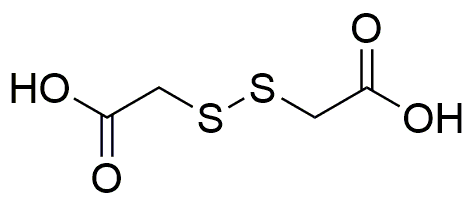Dithiodiglycolic acid is widely utilized in research focused on:
- Cosmetics and Personal Care: This compound is used in formulations for skin care products due to its antioxidant properties, helping to protect skin from oxidative stress and improve overall skin health.
- Pharmaceuticals: It serves as a valuable intermediate in the synthesis of various drugs, particularly those targeting conditions related to oxidative damage, enhancing therapeutic efficacy.
- Biotechnology: Dithiodiglycolic acid is employed in the development of bioconjugates, facilitating the attachment of biomolecules to surfaces or other molecules, which is crucial for drug delivery systems.
- Analytical Chemistry: This compound is utilized in the preparation of reagents for detecting heavy metals in environmental samples, providing a reliable method for assessing contamination levels.
- Textile Industry: It is used as a reducing agent in dyeing processes, improving color uptake and fastness, which enhances the quality of textile products.
General Information
Properties
Safety and Regulations
Applications
Dithiodiglycolic acid is widely utilized in research focused on:
- Cosmetics and Personal Care: This compound is used in formulations for skin care products due to its antioxidant properties, helping to protect skin from oxidative stress and improve overall skin health.
- Pharmaceuticals: It serves as a valuable intermediate in the synthesis of various drugs, particularly those targeting conditions related to oxidative damage, enhancing therapeutic efficacy.
- Biotechnology: Dithiodiglycolic acid is employed in the development of bioconjugates, facilitating the attachment of biomolecules to surfaces or other molecules, which is crucial for drug delivery systems.
- Analytical Chemistry: This compound is utilized in the preparation of reagents for detecting heavy metals in environmental samples, providing a reliable method for assessing contamination levels.
- Textile Industry: It is used as a reducing agent in dyeing processes, improving color uptake and fastness, which enhances the quality of textile products.
Documents
Safety Data Sheets (SDS)
The SDS provides comprehensive safety information on handling, storage, and disposal of the product.
Product Specification (PS)
The PS provides a comprehensive breakdown of the product’s properties, including chemical composition, physical state, purity, and storage requirements. It also details acceptable quality ranges and the product's intended applications.
Certificates of Analysis (COA)
Search for Certificates of Analysis (COA) by entering the products Lot Number. Lot and Batch Numbers can be found on a product’s label following the words ‘Lot’ or ‘Batch’.
*Catalog Number
*Lot Number
Certificates Of Origin (COO)
This COO confirms the country where the product was manufactured, and also details the materials and components used in it and whether it is derived from natural, synthetic, or other specific sources. This certificate may be required for customs, trade, and regulatory compliance.
*Catalog Number
*Lot Number
Safety Data Sheets (SDS)
The SDS provides comprehensive safety information on handling, storage, and disposal of the product.
DownloadProduct Specification (PS)
The PS provides a comprehensive breakdown of the product’s properties, including chemical composition, physical state, purity, and storage requirements. It also details acceptable quality ranges and the product's intended applications.
DownloadCertificates of Analysis (COA)
Search for Certificates of Analysis (COA) by entering the products Lot Number. Lot and Batch Numbers can be found on a product’s label following the words ‘Lot’ or ‘Batch’.
*Catalog Number
*Lot Number
Certificates Of Origin (COO)
This COO confirms the country where the product was manufactured, and also details the materials and components used in it and whether it is derived from natural, synthetic, or other specific sources. This certificate may be required for customs, trade, and regulatory compliance.

